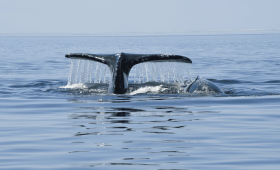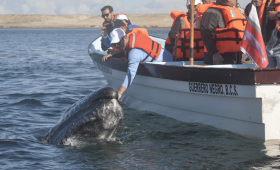Each winter, one of the most awe-inspiring migrations on Earth unfolds beneath the surface of the Pacific Ocean. Grey whales—graceful giants of the sea—embark on an epic journey that spans nearly 10,000 to 12,000 miles round-trip, from the icy waters of the Arctic to the warm, protected lagoons of Baja California, Mexico. But what draws these whales to Baja year after year, generation after generation?
The answer lies in a compelling combination of instinct, biology, safety, and survival—a perfect harmony between nature and geography that has made Baja California a sanctuary for these remarkable animals. In this blog, we’ll explore why grey whales travel to Baja California every year, how they prepare for this journey, and what makes Baja’s coastal lagoons the ideal destination for birthing and bonding.
The Epic Journey Begins in the Arctic
Grey whales (Eschrichtius robustus) spend their summers feeding in the nutrient-rich waters of the Bering and Chukchi Seas, near Alaska and Russia. Here, they gorge themselves on small crustaceans like amphipods found in the muddy seafloor—fueling up for the long trip ahead. During this time, they can consume over 2,000 pounds of food per day, storing thick layers of blubber that will sustain them throughout the migration and fasting period in Baja.
By late October or early November, as the Arctic begins to freeze, the whales begin heading south. Pregnant females typically lead the way, followed by mothers to be or those few mothers already with babies, single adults, and juveniles. The migration is slow but steady, with grey whales traveling between 75 to 100 miles a day at an average speed of 3 to 5 miles per hour.
Why Do Grey Whales Migrate?
Migration in grey whales is driven primarily by reproduction. Unlike many animals that can reproduce and raise their young in the same region year-round, grey whales require two drastically different habitats—one for feeding and one for breeding.
1. Feeding Grounds (Arctic): Cold, nutrient-rich waters provide the high-fat diet grey whales need to survive and reproduce.
2. Breeding Grounds (Baja California): Warm, shallow, and calm lagoons offer the ideal environment for birthing, nursing, and protecting newborn calves.
If they remained in the Arctic year-round, calves would be born into frigid waters where survival rates would plummet due to hypothermia, ice cover, and predation. Baja, on the other hand, provides a sanctuary of warmth and safety.
Why Baja California?
Baja California’s Pacific coast offers several unique features that make it the premier breeding destination for grey whales:
1. Shallow, Warm Waters
Grey whale calves are born without thick blubber layers and are extremely vulnerable to cold temperatures. Baja’s shallow lagoons, such as San Ignacio Lagoon, Magdalena Bay, and Laguna Ojo de Liebre, offer gentle temperatures that help calves conserve energy and regulate body heat.
2. Calm, Protected Lagoons
Unlike the turbulent open ocean, these lagoons are largely protected from rough waves and strong currents. This creates a safe nursery where calves can build strength and coordination before facing the open sea.
3. Low Predation Risk
One of the major threats to grey whale calves is orcas (killer whales), especially in more northern waters. The lagoons of Baja are shallow enough that orcas are unlikely to enter, providing a crucial refuge during the calf's most vulnerable stage.
4. Isolation and Quiet
These secluded lagoons are relatively free from human development and noise pollution. This peaceful environment allows for uninterrupted nursing, bonding, and rest for both mother and calf.
The Birthing Season
Pregnant females often arrive in Baja as early as December. After carrying their young for about 11 - 12 months, they give birth in the lagoons between late December through early February. A newborn grey whale calf can weigh up to 1,500 pounds and measure around 15 feet long at birth.
Immediately after birth, the calf must learn to swim, then begins nursing, consuming high-fat milk that allows it to gain up to 70 pounds per day. During the next several weeks, the mother and calf engage in constant physical contact, nuzzling and swimming side by side in a display of deep bonding.
Social Behavior and Human Interaction
What makes Baja even more extraordinary is the behavior of the grey whales themselves. These massive creatures—once hunted nearly to extinction—now actively seek out human interaction in some areas. They approach small boats, surface beside tourists, and even allow their calves to be gently touched.
This phenomenon, known as “friendly whales,” is unique to Baja’s lagoons. While scientists don’t fully understand the reasons behind this behavior, many believe it’s a sign of trust built over generations of peaceful coexistence. Others think it’s simple curiosity, or perhaps a maternal desire to expose calves to unfamiliar stimuli.
Regardless of the reason, these interactions are always on the whales’ terms. They choose to approach. They choose to connect. And the result is one of the most emotionally powerful wildlife experiences on the planet.
Timing the Migration
The grey whale migration is one of the most predictable natural events in the marine world. Here’s how the typical calendar plays out:
October – November: Migration begins as whales leave the Arctic.
December – January: Early arrivals reach Baja; pregnant females begin giving birth.
February – March: Peak season for whale watching; newborn calves grow stronger.
April – Whales begin the return journey north, calves now strong enough to travel.
The entire round-trip migration takes roughly 3 to 5 months and covers a distance of up to 12,000 miles—making it the longest known migration of any mammal on Earth.
Conservation and Protection
Today, the Eastern North Pacific population of grey whales is considered a conservation success story. Once nearly hunted to extinction, the population has rebounded to approximately 15,000–20,000 individuals, thanks to international protection, marine sanctuaries, and responsible eco-tourism practices. However, the journey is still not without danger. Grey whales face threats from:
1. Climate change affecting Arctic feeding grounds
2. Ship strikes in busy migration routes
3. Noise pollution disrupting communication
4. Plastic and pollution in marine habitats
The importance of Baja’s lagoons cannot be overstated. These sanctuaries offer more than rest—they are lifelines. Continued protection of these areas, along with careful management of whale-watching activities, is essential to the grey whale’s survival.
What This Means for Us
Grey whales remind us of the interconnectedness of our world. Their migration spans countries, ecosystems, and climates. They depend on the Arctic's productivity and Baja’s tranquility to thrive. And in doing so, they bring people from all over the world together in admiration, awe, and responsibility.
By traveling to Baja each year, grey whales don’t just ensure the survival of their species—they also give us a rare window into the rhythms of nature. They teach us patience, resilience, and the value of preserving the places where life begins and flourishes.
Planning Your Visit
If you’re thinking about witnessing this miracle of nature for yourself, Baja California is ready to welcome you. The best time to visit is between January and March, when the number of whales in the lagoons is at its peak. Several tour operators offer ethical and guided whale-watching excursions, with deep respect for the whales and strict regulations to protect their wellbeing.
For most intense immersive experience choose a shore side accommodation in a camp such as Baja Jones whale watching safari camp offers. Follow the rules, and above all—go with an open heart. Whether you see a calf breach for the first time or make eye contact with a curious whale, the experience will stay with you for life.
Final Thoughts
The annual migration of grey whales to Baja California is more than a biological phenomenon—it’s a majestic journey of life, birth, and renewal. It’s a reminder that the natural world is full of wonders still unfolding right before our eyes.
In Baja’s warm waters, new generations of grey whales are born. Bonds are formed. Journeys begin. And if we’re lucky, we get to be part of that story—even for just a moment.
So the next time you stand at the edge of the Pacific or if you are fortunate to be ready to board a panga in Laguna Ojo de Liebre, remember: you are witnessing one of nature’s greatest traditions, a legacy written in waves, passed down from whale to whale, season after season.




